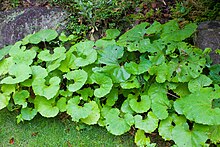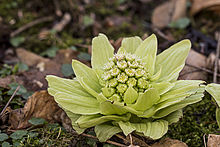Petasites japonicus, also known as butterbur, giant butterbur, great butterbur and sweet-coltsfoot, is an herbaceous perennial plant in the family Asteraceae.[3] It is native to China, Japan, Korea and Sakhalin and introduced in Europe and North America. It was introduced to southern British Columbia in Canada by Japanese migrants.[4][5]
| Giant butterbur | |
|---|---|

| |
| Adult fuki | |

| |
| Fuki shoot | |
| Scientific classification | |
| Kingdom: | Plantae |
| Clade: | Tracheophytes |
| Clade: | Angiosperms |
| Clade: | Eudicots |
| Clade: | Asterids |
| Order: | Asterales |
| Family: | Asteraceae |
| Genus: | Petasites |
| Species: | P. japonicus
|
| Binomial name | |
| Petasites japonicus | |
| Nutritional value per 100 g (3.5 oz) | |||||||||||||||||||||||||||||||||||||||||||
|---|---|---|---|---|---|---|---|---|---|---|---|---|---|---|---|---|---|---|---|---|---|---|---|---|---|---|---|---|---|---|---|---|---|---|---|---|---|---|---|---|---|---|---|
| Energy | 59 kJ (14 kcal) | ||||||||||||||||||||||||||||||||||||||||||
3.61 g | |||||||||||||||||||||||||||||||||||||||||||
0.04 g | |||||||||||||||||||||||||||||||||||||||||||
0.39 g | |||||||||||||||||||||||||||||||||||||||||||
| |||||||||||||||||||||||||||||||||||||||||||
| †Percentages estimated using US recommendations for adults,[1] except for potassium, which is estimated based on expert recommendation from the National Academies.[2] | |||||||||||||||||||||||||||||||||||||||||||

It is dioecious, with male and female flowers produced on separate individuals. Occasionally, morphologically hermaphroditic (but functionally sterile) flowers exist.[6]
Culinary usage
editThe traditional preparation method for this vegetable involves pre-treating with ash or baking soda and soaking in water to remove harshness (astringency), which is a technique known as aku-nuki (灰汁抜き, literally "harshness removal"). The shoot can be chopped and stir fried with miso to make fuki-miso which is eaten as a relish thinly spread over hot rice at meals. The bulb-like shoots are also picked fresh and fried as tempura. In Korea, it is steamed or boiled and then pressed to remove water. Sesame oil or perilla oil is added in order to make namul.
Toxicity
editLike other Petasites species, fuki contains pyrrolizidine alkaloids (PAs) which have been associated with cumulative damage to the liver and tumor formation.[7][8] It also contains the carcinogenic PA petasitenine.[8] The concentration of hepatotoxic PAs can be reduced to a concentration below detection limits with a proper extraction process.[9] Since many alkaloids are bitter, traditional methods of preparation may have evolved to remove them.
Animal studies
editCertain extracts of Petasites japonicus have found to be anti-inflammatory in a study of asthma in mice.[10] Based on additional studies in mice, the plant may contain blood plasma and hepatic lipid-lowering and antioxidant compounds.[11]
Folklore
editThe Ainu people refer to the previous inhabitants of Ezo as the Korpokkur or "people who dwelt below ground"; the name can also be interpreted as "people beneath the fuki", and so they are popularly associated with fuki leaves in art and mythology. More fantastic depictions of the Korpokkur portray them as tiny, fairy-like creatures small enough to use the leaves as roofs or umbrellas.[12]
References
edit- ^ United States Food and Drug Administration (2024). "Daily Value on the Nutrition and Supplement Facts Labels". FDA. Archived from the original on 2024-03-27. Retrieved 2024-03-28.
- ^ National Academies of Sciences, Engineering, and Medicine; Health and Medicine Division; Food and Nutrition Board; Committee to Review the Dietary Reference Intakes for Sodium and Potassium (2019). Oria, Maria; Harrison, Meghan; Stallings, Virginia A. (eds.). Dietary Reference Intakes for Sodium and Potassium. The National Academies Collection: Reports funded by National Institutes of Health. Washington, DC: National Academies Press (US). ISBN 978-0-309-48834-1. PMID 30844154. Archived from the original on 2024-05-09. Retrieved 2024-06-21.
- ^ "Petasites japonicus". Germplasm Resources Information Network. Agricultural Research Service, United States Department of Agriculture.
- ^ Pojar, Jim; MacKinnon, Andy (1994). Plants of the Pacific Northwest Coast. Lone Pine Publishing. p. 294. ISBN 978-1-55105-040-9.
- ^ Fawcett-Atkinson, Marc (18 June 2021). "Why a Japanese Delicacy Grows Near Old British Columbia Internment Camps". Atlas Obscura. Retrieved 30 June 2021.
- ^ Sakai, Satoki; Suzuki, Yuka; Itagaki, Tomoyuki; Tsujisawa, Hisashi; Makino, Takashi T. (2008). "On the function of hermaphrodite florets in female inflorescences of Petasites japonicus (Asteraceae)". Botany. 86 (2): 179–184. doi:10.1139/B07-121.
- ^ Fu, P.P.; Yang, Y.C.; Xia, Q.; Chou, M.C.; Cui, Y.Y.; Lin G. (2002). "Pyrrolizidine alkaloids-tumorigenic components in Chinese herbal medicines and dietary supplements". Journal of Food and Drug Analysis. 10 (4): 198–211.[dead link]
- ^ a b Maxim Hirono I.; Mori H.; Yamada K. (1977). "Carcinogenic activity of petasitenine, a new pyrrolizidine alkaloid isolated from Petasites japonicus". Journal of the National Cancer Institute. 58 (4): 1155–1157. doi:10.1093/jnci/58.4.1155. PMID 191625.
- ^ Kalin P.; Buel E.S. "The common butterbur - Petasites hybridus. Portrait of a medicinal herb: History, pharmacology, clinical applications". Schweizerische Zeitschrift für Ganzheitsmedizin. 14 (5): 267–274.
- ^ Lee J.-S.; Yang E.J.; Yun C.-Y.; Kim D.-H.; Kim I.S. (2011). "Suppressive effect of Petasites japonicus extract on ovalbumin-induced airway inflammation in an asthmatic mouse model". Journal of Ethnopharmacology. 133 (2): 551–557. doi:10.1016/j.jep.2010.10.038. PMID 21029770.
- ^ Park C.H.; Kim M.Y.; Sok D.-E.; Kim J.H.; Lee J.H.; Kim M.R. (2010). "Butterbur (Petasites japonicus Max.) extract improves lipid profiles and antioxidant activities in monosodium L-glutamate-challenged mice". Journal of Medicinal Food. 13 (5): 1216–1223. doi:10.1089/jmf.2009.1380. PMID 20828319.
- ^ John Batchelor (1904). The Koropok-Guru or pit-dwellers of north Japan, and, A critical examination of the nomenclature of Yezo, Volume 19. YOKOHAMA: Japan Mail. p. https://archive.org/details/koropokguruorpi00batcgoog/page/n13/mode/1up. Retrieved 25 October 2020.
External links
edit- Media related to Petasites japonicus at Wikimedia Commons
- "Petasites japonicus". Plants for a Future.
- Recipes from Yasuko-san's Home Cooking
- Traditional itazuri technique